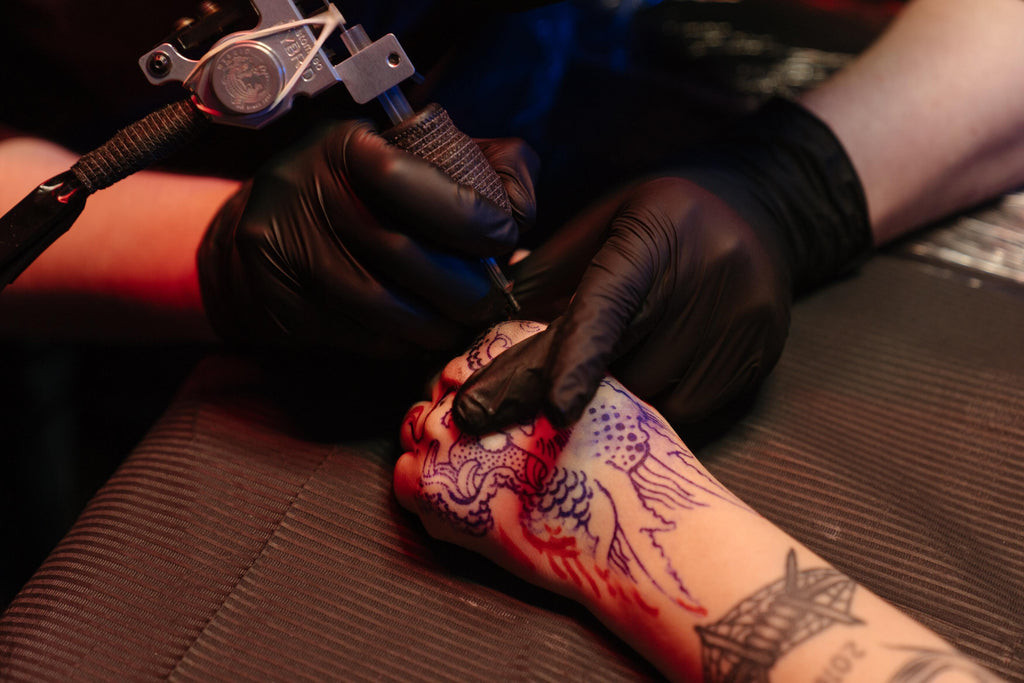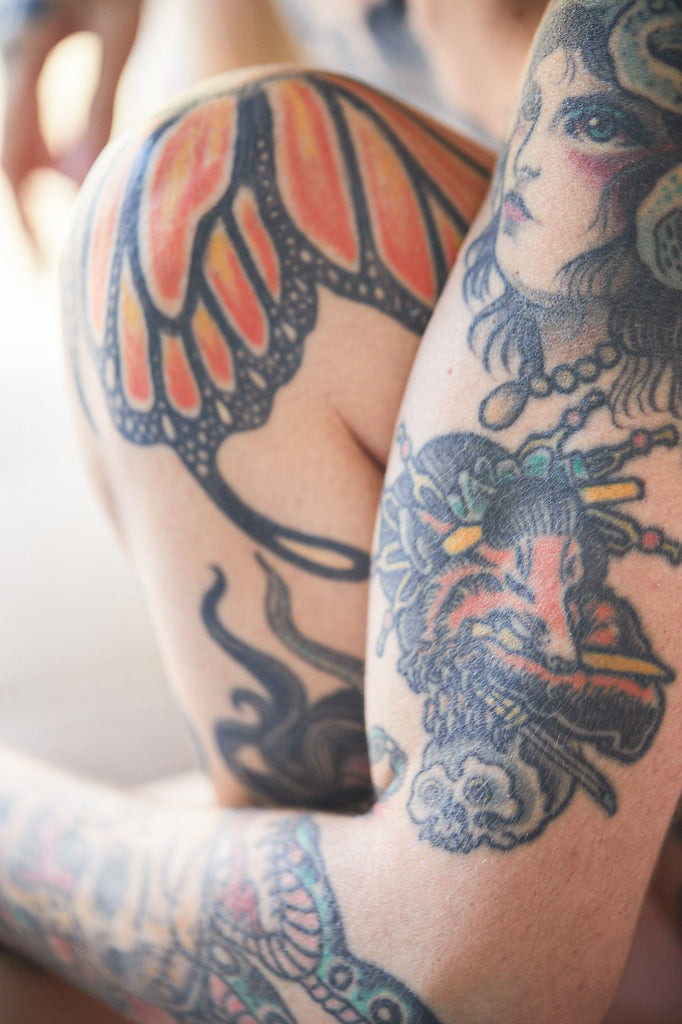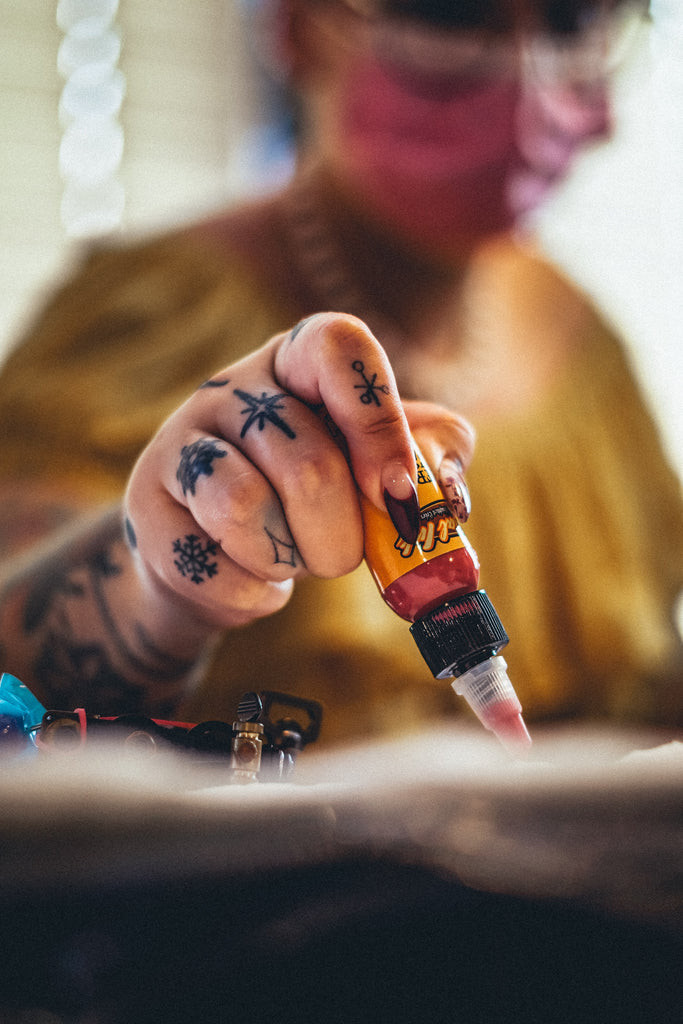Does the question, “How long does a tattoo stay raised?” linger in your mind? It’s a common concern for those adorned with or considering body art. At tattooat.com, we address this and other frequently asked questions, offering insights, design inspiration, and connections to talented artists to ensure a smooth and satisfying tattoo journey. This comprehensive guide provides information on why tattoos become raised and how to care for them, along with tattoo aftercare tips, ink reactions, and touch-up advice.
1. Why Is My Tattoo Raised?
Understanding the reasons behind a raised tattoo can ease your concerns. Several factors can contribute to this phenomenon:
- Fresh Ink: Newly applied tattoos are essentially open wounds. The tattooing process involves needles repeatedly puncturing the skin, which naturally leads to inflammation and swelling as the body begins to heal. This initial swelling can make the tattoo lines feel raised to the touch.
- Scar Tissue: In some instances, especially with older tattoos, the raised feeling may be due to scar tissue formation. When a tattoo artist applies too much pressure or works over the same area repeatedly, it can cause trauma to the skin, resulting in scarring. This scar tissue can become more noticeable over time, especially during changes in temperature or humidity.
- Allergic Reactions: Although rare, allergic reactions to tattoo ink can also cause the tattoo to become raised and itchy. Certain pigments, particularly red and yellow, are more likely to trigger an allergic response in sensitive individuals. These reactions can occur immediately after getting the tattoo or develop years later.
- Environmental Factors: External factors such as weather conditions, humidity levels, and even seasonal changes can affect the skin and cause tattoos to become raised. For example, warm weather and high humidity can cause the skin to swell slightly, making the tattoo lines more prominent. Conversely, dry winter air can lead to skin dehydration, causing the tattoo to feel rough and raised.
- Skin Conditions: Pre-existing skin conditions like eczema, psoriasis, or dermatitis can also contribute to a raised tattoo. These conditions can cause inflammation and irritation, making the tattoo lines more noticeable and uncomfortable.
- Trauma: In some instances, trauma to the skin around the tattoo can cause it to become raised.
To ensure proper healing and minimize the risk of complications, it is crucial to follow your tattoo artist’s aftercare instructions diligently and seek professional medical advice if you suspect an allergic reaction or infection.
2. How Long Does It Take for a New Tattoo to Flatten?
A new tattoo typically takes 2 to 4 weeks to heal, during which time the initial swelling and raised feeling should gradually subside. However, the exact timeline can vary depending on several factors, including:
- Tattoo Size and Placement: Larger tattoos or those located on areas with thinner skin, such as the wrists or ankles, may take longer to heal and flatten.
- Individual Healing Rate: Everyone heals at their own pace. Factors like age, overall health, and immune system function can affect the healing process.
- Aftercare Routine: Following your tattoo artist’s aftercare instructions diligently is crucial for proper healing. This includes keeping the tattoo clean and moisturized, avoiding excessive sun exposure, and refraining from picking or scratching the area.
According to research from Portland State University’s Art Department, in July 2023, proper aftercare and moisturizing promote faster healing and reduce the likelihood of prolonged elevation. If your tattoo remains raised after a month, consult your tattoo artist or a dermatologist to rule out any underlying issues.
3. Can Old Tattoos Become Raised Years Later?
Yes, old tattoos can become raised years after they have fully healed. This phenomenon can be attributed to several factors:
- Scar Tissue Formation: Even if a tattoo initially heals without any noticeable scarring, microscopic scar tissue can still form beneath the surface of the skin. Over time, this scar tissue can become more prominent, causing the tattoo lines to feel raised, particularly when exposed to certain environmental factors.
- Allergic Reactions: Allergic reactions to tattoo ink can develop years after getting the tattoo. Delayed hypersensitivity reactions can occur when the immune system recognizes the tattoo pigment as a foreign substance and triggers an inflammatory response. This can cause the tattoo to become raised, itchy, and inflamed.
- Changes in Skin Elasticity: As we age, our skin naturally loses elasticity and collagen, which can make tattoos appear raised or distorted. The skin may become thinner and more susceptible to environmental factors, making the tattoo lines more prominent.
- Underlying Skin Conditions: Skin conditions like eczema, psoriasis, or dermatitis can flare up years after getting a tattoo, causing inflammation and irritation around the tattooed area. This can make the tattoo lines more noticeable and uncomfortable.
If you notice an old tattoo becoming raised, it is important to consult a dermatologist to determine the underlying cause and receive appropriate treatment.
 Traditional tattoo featuring bold linework and vibrant colors, highlighting the artistry of classic tattoo designs.
Traditional tattoo featuring bold linework and vibrant colors, highlighting the artistry of classic tattoo designs.
4. What Does It Mean When a Tattoo Is Raised in Certain Spots?
Localized raising in specific areas of a tattoo can indicate several potential issues:
- Uneven Healing: If only certain parts of your tattoo feel raised, it could be due to uneven healing. This can occur if some areas of the tattoo were overworked during the tattooing process, leading to more inflammation and scar tissue formation.
- Ink Saturation: Inconsistent ink saturation can also cause localized raising. If the tattoo artist applied more ink to certain areas than others, those areas may become more raised as the skin heals.
- Allergic Reaction: Localized allergic reactions can cause specific parts of the tattoo to become raised, itchy, and inflamed. This is more likely to occur with certain ink colors, such as red or yellow.
- Infection: Although less common, localized raising can also be a sign of a localized infection. If you notice redness, swelling, pain, or pus around a specific area of your tattoo, seek medical attention immediately.
To determine the exact cause of localized raising, consult your tattoo artist or a dermatologist. They can assess the area and recommend appropriate treatment options.
5. Why Does My Tattoo Get Raised When I’m Hot?
Many people notice their tattoos become more raised when they are hot, whether due to exercise, warm weather, or a hot shower. This phenomenon is related to the body’s natural response to heat:
- Vasodilation: When the body temperature rises, blood vessels dilate (widen) to help dissipate heat. This vasodilation can cause the skin to swell slightly, making the tattoo lines more prominent and raised.
- Increased Blood Flow: Increased blood flow to the skin can also contribute to the raised feeling. As more blood rushes to the surface, it can cause the skin to become more sensitive and the tattoo lines to feel more pronounced.
- Sweating: Sweating can also play a role. When sweat evaporates, it can leave behind salt crystals that irritate the skin, making the tattoo feel raised and itchy.
This temporary raising of the tattoo is usually harmless and should subside once the body temperature returns to normal. However, if you experience excessive swelling, redness, or pain, consult a medical professional.
6. How to Tell If Your Raised Tattoo Is Infected
While a raised tattoo is not always a cause for concern, it is important to be able to recognize the signs of infection:
| Symptom | Description |
|---|---|
| Excessive Redness | The skin around the tattoo is significantly redder than normal and the redness is spreading. |
| Swelling | The tattoo is excessively swollen and painful to the touch. |
| Pus | Yellowish or greenish fluid is oozing from the tattoo. |
| Pain | The tattoo is increasingly painful and throbbing. |
| Fever | You develop a fever or chills. |
| Foul Odor | A foul odor is emanating from the tattoo. |
If you experience any of these symptoms, seek medical attention immediately. An infected tattoo can lead to serious complications if left untreated.
7. What Can You Put on a Raised Tattoo?
The appropriate treatment for a raised tattoo depends on the underlying cause. Here are some general guidelines:
- New Tattoos: For new tattoos, continue following your tattoo artist’s aftercare instructions. This typically involves keeping the tattoo clean and moisturized with a fragrance-free lotion or ointment. Avoid picking or scratching the area, as this can increase the risk of infection and scarring.
- Old Tattoos: For old tattoos that become raised due to dryness or environmental factors, apply a moisturizing lotion regularly to keep the skin hydrated.
- Allergic Reactions: If you suspect an allergic reaction, consult a dermatologist. They may recommend a topical corticosteroid cream or antihistamine to relieve itching and inflammation.
- Infections: If you suspect an infection, seek medical attention immediately. A doctor may prescribe antibiotics to treat the infection.
It is important to avoid using harsh chemicals, alcohol-based products, or abrasive scrubs on a raised tattoo, as these can further irritate the skin.
8. How to Prevent Tattoos From Becoming Raised
While it is not always possible to prevent tattoos from becoming raised, there are several steps you can take to minimize the risk:
- Choose a Reputable Artist: Select a tattoo artist with experience and a good reputation. A skilled artist will use proper techniques to minimize trauma to the skin and ensure proper ink saturation.
- Follow Aftercare Instructions: Adhere to your tattoo artist’s aftercare instructions diligently. This includes keeping the tattoo clean, moisturized, and protected from the sun.
- Avoid Overworking the Skin: If you are getting a large or complex tattoo, consider breaking it up into multiple sessions to avoid overworking the skin.
- Stay Hydrated: Drinking plenty of water can help keep your skin hydrated and healthy, which can reduce the risk of inflammation and scarring.
- Protect From the Sun: Sun exposure can damage the skin and cause tattoos to fade or become raised. Apply a broad-spectrum sunscreen with an SPF of 30 or higher to your tattoo whenever you are outdoors.
By following these precautions, you can help ensure your tattoos heal properly and remain vibrant for years to come.
 A collection of tattoo designs showcasing various styles, including watercolor, geometric, and minimalist, appealing to diverse artistic preferences.
A collection of tattoo designs showcasing various styles, including watercolor, geometric, and minimalist, appealing to diverse artistic preferences.
9. Tattoo Touch-Ups: Will They Fix a Raised Tattoo?
Tattoo touch-ups can sometimes improve the appearance of a raised tattoo, but they are not always a guaranteed solution. The effectiveness of a touch-up depends on the underlying cause of the raising:
- Scar Tissue: If the tattoo is raised due to scar tissue, a touch-up may not completely eliminate the elevation. However, a skilled artist can sometimes camouflage the scar tissue by adding more ink to the surrounding areas.
- Uneven Ink Saturation: If the tattoo is raised due to uneven ink saturation, a touch-up can help even out the ink distribution and reduce the raised feeling.
- Fading: If the tattoo is raised due to fading, a touch-up can restore the color and definition, making the tattoo appear more vibrant and less raised.
Before getting a touch-up, consult your tattoo artist to discuss your concerns and determine if a touch-up is the right solution for your raised tattoo.
10. What Are the Risks of Getting a Tattoo?
While tattoos can be a beautiful form of self-expression, it is important to be aware of the potential risks involved:
- Allergic Reactions: Allergic reactions to tattoo ink can cause itching, swelling, and inflammation. In rare cases, severe allergic reactions can lead to anaphylaxis, a life-threatening condition.
- Infections: Infections can occur if the tattoo equipment is not properly sterilized or if the tattoo is not properly cared for after it is applied. Infections can lead to scarring, disfigurement, and even serious health complications.
- Scarring: Scarring can occur if the tattoo artist applies too much pressure or if the tattoo is not properly cared for after it is applied.
- Granulomas: Granulomas are small nodules that can form around tattoo ink. They are usually harmless but can be unsightly and uncomfortable.
- MRI Complications: In rare cases, tattoos can cause complications during magnetic resonance imaging (MRI) scans. The tattoo ink can heat up and cause burns.
To minimize the risks of getting a tattoo, choose a reputable artist, follow aftercare instructions diligently, and inform your doctor about your tattoo before undergoing any medical procedures.
FAQ: Addressing Your Concerns About Raised Tattoos
Here are some frequently asked questions about raised tattoos:
- Is it normal for a new tattoo to be raised? Yes, it’s common for new tattoos to feel raised due to inflammation and swelling.
- Why is my old tattoo suddenly raised? This could be due to scar tissue, allergic reactions, changes in skin elasticity, or underlying skin conditions.
- Can weather affect my tattoo? Yes, hot weather can cause vasodilation, making tattoos more prominent, while dry weather can make them feel rough.
- How can I tell if my raised tattoo is infected? Look for excessive redness, swelling, pus, pain, fever, or a foul odor. Seek medical attention immediately if you suspect an infection.
- What should I put on my raised tattoo? For new tattoos, continue with aftercare; for old tattoos, use moisturizing lotion; for allergic reactions, consult a dermatologist.
- Will a tattoo touch-up fix a raised tattoo? It depends on the cause; it can help with uneven ink saturation or fading but may not eliminate scar tissue.
- How can I prevent my tattoo from becoming raised? Choose a reputable artist, follow aftercare instructions, stay hydrated, and protect your tattoo from the sun.
- Are certain tattoo inks more likely to cause a raised tattoo? Red and yellow inks are more likely to cause allergic reactions, potentially leading to a raised tattoo.
- Can skin conditions like eczema affect my tattoo? Yes, eczema can cause inflammation and irritation around the tattooed area, making it more noticeable.
- When should I see a doctor about my raised tattoo? See a doctor if you suspect an infection, allergic reaction, or if the raising persists despite proper care.
 A close-up shot of a tattoo artist working on a detailed sleeve tattoo, showcasing the precision and skill involved in professional tattooing.
A close-up shot of a tattoo artist working on a detailed sleeve tattoo, showcasing the precision and skill involved in professional tattooing.
Ready to explore the world of tattoos with confidence? Visit tattooat.com today for inspiration, artist connections, and expert advice. Discover designs that resonate with you, find the perfect artist to bring your vision to life, and learn everything you need to know about tattoo care.
Address: 1825 SW Broadway, Portland, OR 97201, United States
Phone: +1 (503) 725-3000
Website: tattooat.com